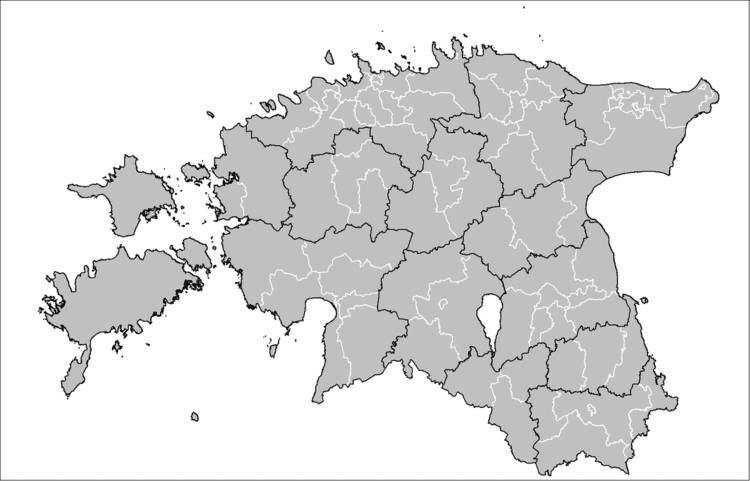 | ||
A municipality (Estonian: omavalitsus, plural omavalitsused) is the smallest administrative subdivision of Estonia. Each municipality is a unit of self-government with its representative and executive bodies. The municipalities in Estonia cover the entire territory of the country.
Contents
- Harju County
- Hiiu County
- Ida Viru County
- Jrva County
- Jgeva County
- Lne County
- Lne Viru County
- Prnu County
- Plva County
- Rapla County
- Saare County
- Tartu County
- Valga County
- Viljandi County
- Vru County
- Structure of local authorities
- References
Municipalities in Estonia are of two types: urban municipalities or towns (linnad, singular linn) and rural municipalities or parishes (vallad, singular vald). There is no other status distinction between them.
Municipality may contain one or several settlements. All urban municipalities plus 6 rural municipalities contain only one settlement. Of the latter six, 5 are so-called "borough-parishes", consisting of one borough, while Ruhnu Parish consists of one village.
Some municipalities are divided into districts. The 8 urban districts (linnaosad, singular linnaosa) of Tallinn have limited self-government, while other urban districts are formed for administrative purposes. Some rural districts (osavallad) have limited self-government, while other types of rural districts do not.
Municipalities range in population from Tallinn with 427,500 inhabitants to Ruhnu with 68. As over two-thirds of the municipalities have a population of under 3,000, many of them have found it advantageous to co-operate in providing services and carrying out administrative functions.
Currently, since 12 December 2014, there are total of 213 municipalities, 30 of which are urban and 183 rural. By county, these are:
Harju County
23 municipalities (6 urban, 17 rural)
Urban municipalities:
Rural municipalities:
Hiiu County
4 rural municipalities
Rural municipalities:
Ida-Viru County
20 municipalities (5 urban, 15 rural)
Urban municipalities:
Rural municipalities:
Järva County
12 municipalities (1 urban, 11 rural)
Urban municipalities:
Rural municipalities:
Jõgeva County
13 municipalities (3 urban, 10 rural)
Urban municipalities:
Rural municipalities:
Lääne County
10 municipalities (1 urban, 9 rural)
Urban municipality:
Rural municipalities:
Lääne-Viru County
15 municipalities (2 urban, 13 rural)
Urban municipalities:
Rural municipalities:
Pärnu County
19 municipalities (2 urban, 17 rural)
Urban municipalities:
Rural municipalities:
Põlva County
13 rural municipalities
Rural municipalities:
Rapla County
10 rural municipalities
Rural municipalities:
Saare County
14 municipalities (1 urban, 13 rural)
Urban municipality:
Rural municipalities:
Tartu County
22 municipalities (3 urban, 19 rural)
Urban municipalities:
Rural municipalities:
Valga County
13 municipalities (2 urban, 11 rural)
Urban municipality:
Rural municipalities:
Viljandi County
12 municipalities (3 urban, 9 rural)
Urban municipalities:
Rural municipalities:
Võru County
13 municipalities (1 urban, 12 rural)
Urban municipality:
Rural municipalities:
Structure of local authorities
In each municipality there is a local government as well as a council.
The council (volikogu) is a representative body elected by the residents of a municipality for a term of three years. The members of the council elect a chairman (volikogu esimees), who organises the council’s work and represents the municipality.
The government (valitsus) is an executive body formed by the council. It is headed by a mayor (linnapea in towns, vallavanem in parishes), who is appointed for a four-year term. The mayor cannot be the chairman of the council. Other members of the government are chosen by the mayor with the approval of the council.
